Anchoring and fishing rules to stop the spread of exotic caulerpa
You must follow the rules in the mapped areas at these 5 locations.


Find out about the legal controlled area notices that are in place in 5 upper North Island locations and what you need to do.
You must follow the rules in the mapped areas at these 5 locations.
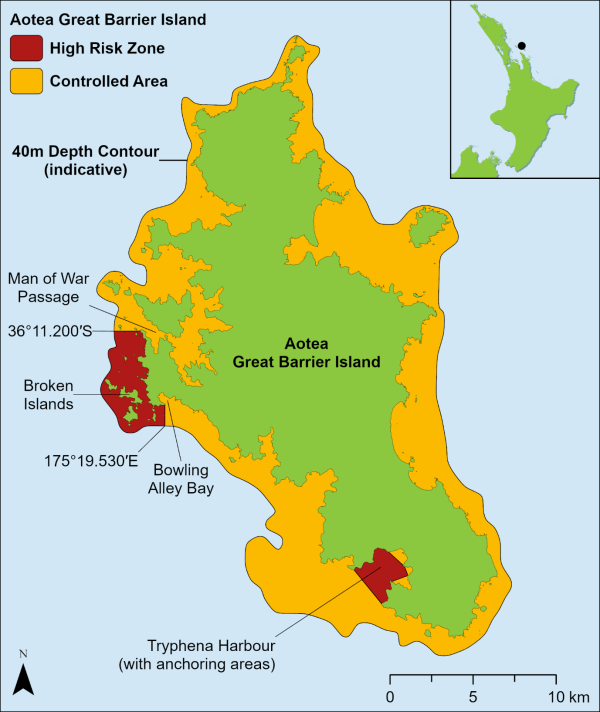
The controlled area extends around the entire island out to a 40 metre depth contour.
Most of the controlled area is a yellow zone with ‘check and clean’ rules in place.
Anchoring is allowed in the yellow zone.
However, before moving location (either within the controlled area or out of the controlled area), operators must:
In the yellow zone, no fishing is allowed that uses a method that disturbs the sea floor. The following are prohibited:
The following fishing activities are allowed in the yellow zone.
Before moving location, you must check your fishing equipment and dive gear for any attached seaweed, remove it, bag it, and bin it onshore.
Clean any equipment thoroughly before reusing it in the ocean.
There are 2 red zones at Aotea Great Barrier Island. These are around the Broken Islands and in Tryphena Harbour.
In these 2 areas, anchoring is illegal without a permit issued by Biosecurity New Zealand. A permit is not required in the event of an emergency where there is no other safe sheltering or mooring location.
To apply for an anchoring exemption permit (for the two CAN red zones), complete the application form and email it to caulerpa@mpi.govt.nz
Permit application form for anchoring or moving vessels [PDF, 185 KB]
Permitting guidelines for anchoring [PDF, 1.5 MB]
In the red zones, no fishing is allowed that uses a method that makes contact with the sea floor:
Permits may be issued in exceptional circumstances for rock lobster fishing within the CAN area.
Permit application for a permit to fish for rock lobster in exceptional circumstances [PDF, 191 KB]
Permitting specifications commercial rock lobster potting [PDF, 1.4 MB]
The following fishing activities are allowed in the red zone.
Clean any equipment thoroughly before reusing it in the ocean.
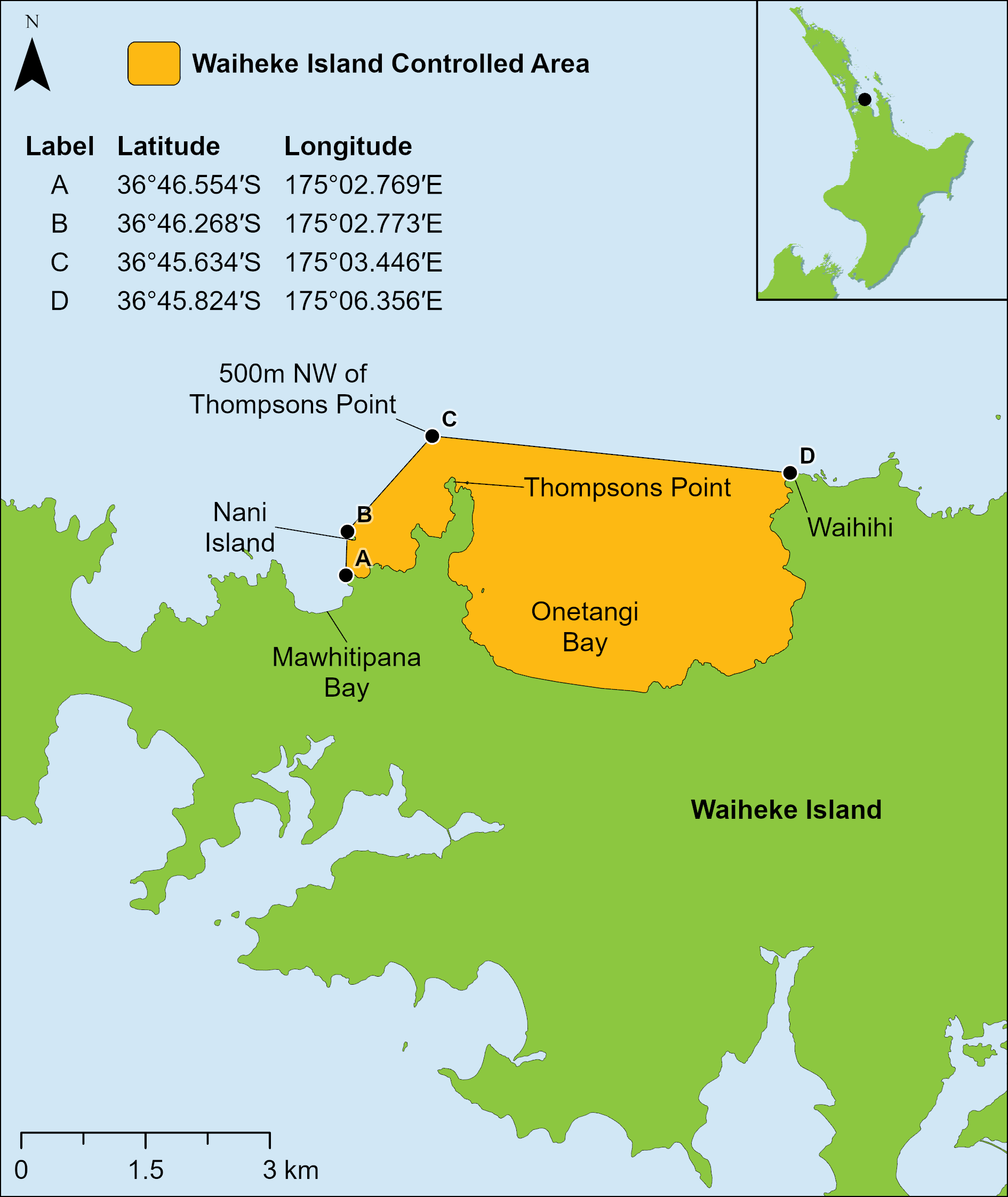
The controlled area extends from the western point of Mawhitipana Bay, north including Nani Island, northwest to 500 metres off Thompson Point and finishing at Waihihi Point on the eastern side of Onetangi Bay. It includes the marine waters of Onetangi Bay and Thompsons Point, Waiheke Island, up to and including the high-tide mark and to a depth of 22 metres.
This entire controlled area is a yellow zone with ‘check and clean’ rules in place.
Anchoring is allowed in the yellow zone.
However, before moving location (either within the controlled area or out of the controlled area) operators must:
In this yellow zone, no fishing is allowed that uses a method that disturbs the sea floor. The following are prohibited:
The following fishing activities are allowed in the yellow zone.
Before moving location, you must check your fishing equipment and dive gear for any attached seaweed, remove it, bag it, and bin it onshore.
Clean any equipment thoroughly before reusing it in the ocean.
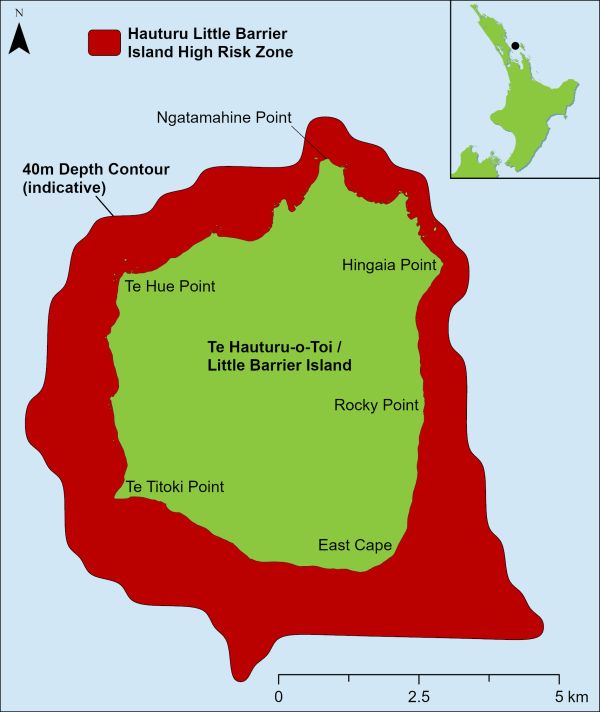
The controlled area surrounds the entire Hauturu-o-Toi Little Barrier Island, up to and including the high-tide mark and to a depth of 40 metres.
The entire controlled area is a red high-risk and high-value zone. Anchoring any vessel inside this controlled area is prohibited without a permit from Biosecurity New Zealand. Anchoring without a permit is allowed in the event of an emergency where no other alternative safe sheltering location or mooring can be easily found.
Permit application form for anchoring or moving vessels [PDF, 185 KB]
Permitting guidelines for anchoring [PDF, 1.5 MB]
There are restrictions on some fishing activities within the controlled area that make contact with the seafloor (and can therefore spread exotic caulerpa). The following fishing methods are prohibited:
Permits may be issued in exceptional circumstances for rock lobster fishing within the CAN area.
Permit application for a permit to fish for rock lobster in exceptional circumstances [PDF, 191 KB]
Permitting specifications commercial rock lobster potting [PDF, 1.4 MB]
Line fishing from the shore or drift fishing from an unanchored vessel is allowed. Spearfishing and hand-gathering are also allowed.
Before taking a vessel into or out of the controlled area, you must:
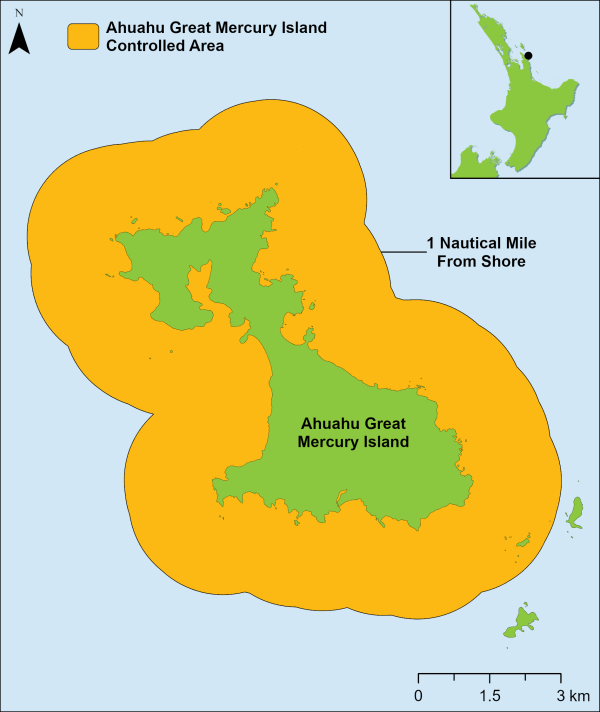
The controlled area at Ahuahu Great Mercury Island extends around the entire coastline of the island and out to one nautical mile from shore.
The entire controlled area is a yellow zone with ‘check and clean’ rules in place.
Anchoring is allowed in the yellow zone.
However, before moving location (either within the controlled area or out of the controlled area), operators must:
In this yellow zone, no fishing is allowed that uses a method that disturbs the sea floor. The following are prohibited:
The following fishing activities are allowed in the yellow zone.
Before moving location, you must check your fishing equipment and dive gear for any attached seaweed, remove it, bag it, and bin it onshore.
Clean any equipment thoroughly before reusing it in the ocean.
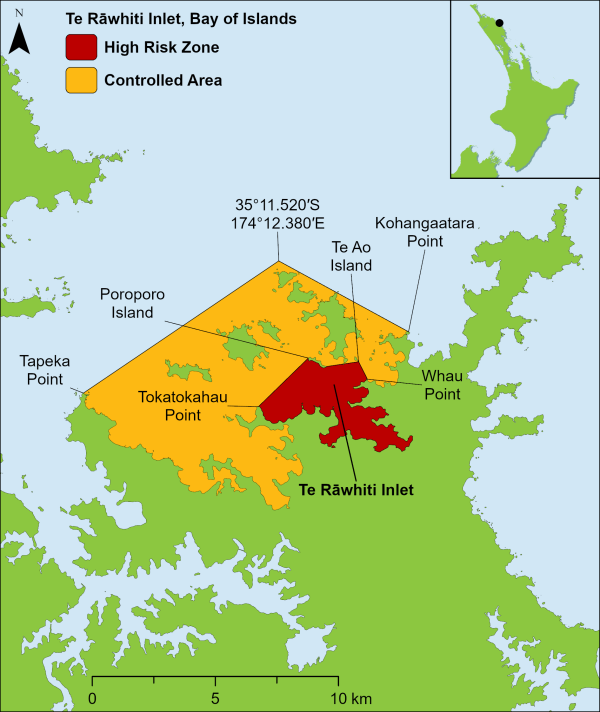
The controlled area extends from Tapeka Point in the west to a position above Okahu Island, then in a straight line down to Kohangaatara Point, encompassing Motuarohia Island, Moturua Island, Motukiekie Island, Waewaetorea Island and Urupukapuka Island.
Most of the controlled area is a yellow zone with ‘check and clean’ rules in place, but there is a red high-risk and high-value area in Te Rāwhiti Inlet.
Anchoring is allowed in the yellow zone.
However, before moving location (either within the controlled area or out of the controlled area) operators must:
In the yellow zone, no fishing is allowed that uses a method that disturbs the sea floor.
The following are prohibited:
The following fishing activities are allowed in the yellow zone.
Before moving location, you must check your fishing equipment and dive gear for any attached seaweed, remove it, bag it, and bin it onshore.
Clean any equipment thoroughly before reusing it in the ocean.
The red zone covers Te Rāwhiti Inlet and Omakiwi Cove. In this zone, anchoring is illegal without a permit issued by Biosecurity New Zealand. A permit is not required in the event of an emergency where there is no other safe sheltering or mooring location.
In this red zone, no fishing of any kind or diving are allowed.
To apply for an anchoring exemption permit (for all areas of the CAN red zone), complete the application form and email it to caulerpa@mpi.govt.nz
Permitting specifications for anchoring [PDF, 1.5 MB]
Permit application form for anchoring or moving vessels [PDF, 185 KB]
These legal rules help prevent the spread of exotic caulerpa seaweed, which can be moved to new locations when caught up on anchors, anchor chains, and fishing and diving equipment.
There are 2 levels of controls depending on the extent of exotic caulerpa and the cultural or ecological value of an affected area (zone).
Information about exotic caulerpa and the legal rules for the Hauraki Gulf area [PDF, 3.7 MB]
Information about exotic caulerpa and the legal rules for Te Tai Tokerau Northland [PDF, 6.1 MB]
Exotic Caulerpa Controlled Area Notice Aotea Great Barrier Island October 2025 [PDF, 879 KB]
Exotic Caulerpa Controlled Area Notice Waiheke Island October 2025 [PDF, 532 KB]
Exotic Caulerpa Controlled Area Notice Hauturu Little Barrier Island October 2025 [PDF, 438 KB]
Exotic Caulerpa Controlled Area Notice Ahuahu Great Mercury Island 2025 [PDF, 422 KB]
Exotic Caulerpa Controlled Area Notice Te Rāwhiti Inlet, Bay of Islands October 2025 [PDF, 871 KB]
In general, it’s safest to avoid the known areas of caulerpa when boating and fishing.
All water users should keep their boats and gear free of any seaweed before moving locations.
Check our advice about how you can help stop the spread
Keep an eye out for exotic caulerpa species and report suspected sightings to us. Take a photo, if possible, and note the location. Then either:






MPI uses cookies to improve your experience on our site. By using our website, you accept our use of cookies.
